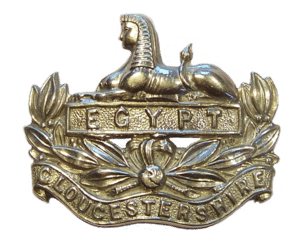The Gloucestershire Regiment


The Gloucestershire Regiment, commonly referred to as the Glosters, was a line infantry regiment of the British Army from 1881 until 1994. It traced its origins to Colonel Gibson's Regiment of Foot raised in 1694, which later became the 28th (North Gloucestershire) Regiment of Foot. The regiment was formed by the merger of the 28th Regiment with the 61st (South Gloucestershire) Regiment of Foot. It inherited the unique privilege in the British Army of wearing a badge on the back of its headdress as well as the front, an honour won by the 28th Regiment when it fought in two ranks back to back at the Battle of Alexandria in 1801. At its formation the regiment comprised two regular, two militia and two volunteer battalions, and saw its first action during the Second Boer War.
Before the First World War, the regiment's four auxiliary battalions were converted to three Territorial Force battalions and a reserve battalion, and a further 18 battalions were added to the regiment's establishment during the war. Sixteen battalions of the regiment saw active service in France and Flanders, Italy, Gallipoli, Egypt, Mesopotamia, Persia and Salonika, losing a total of 8,100 men killed and winning 72 different battle honours. Four awards of the Victoria Cross (VC) were made to soldiers serving with the regiment.
The wartime battalions were disbanded as the war ended, and just before the Second World War, two of the territorial battalions were re-purposed and ceased to have any affiliation with the regiment. On the eve of the war, the remaining territorial battalion was duplicated, and another five battalions were raised on the outbreak of war, though most of these were disbanded or re-purposed as the war progressed. Four battalions saw active service under the regiment's colours during the war. The 2nd and 5th Battalions both fought in the Battle of France and, after being lost almost in its entirety during the Battle of Dunkirk, the re-formed 2nd Battalion landed at Gold Beach on D-Day and fought in the Allied campaign in North-West Europe. The 1st Battalion was involved in the retreat from Rangoon during the Japanese conquest of Burma, and the 10th Battalion saw active service in the defeat of Japanese forces during the Burma Campaign 1944–45.
After the Second World War, the hostilities-only battalions were disbanded and the 1st and 2nd Battalions were amalgamated, leaving the regiment with one regular and one Territorial Army battalion. It achieved fame during the Korean War when the 1st Battalion held out for three nights against overwhelming odds during the Battle of the Imjin River. The stand, described by the commander of the United Nations forces in Korea at the time as "the most outstanding example of unit bravery in modern war", prevented the encirclement of other United Nations forces, for which the regiment was awarded the Presidential Unit Citation and earned the nickname The Glorious Glosters. Two men serving with the regiment were awarded the VC for their actions in the battle. In the latter half of the 20th century, the regiment was reduced to a single regular battalion and completed tours of duty around the world, including Germany, Africa, the Caribbean, Central America and the Middle East, as well as in Northern Ireland during The Troubles.
Shortly after celebrating its tercentenary in 1994, the regiment, which carried more battle honours on its colours than any other regiment of the line, was merged with the Duke of Edinburgh's Royal Regiment to form the Royal Gloucestershire, Berkshire and Wiltshire Regiment. The new regiment inherited the back badge, and when it too was merged in 2007, it passed the tradition on to its successor, The Rifles.
Further Information:

